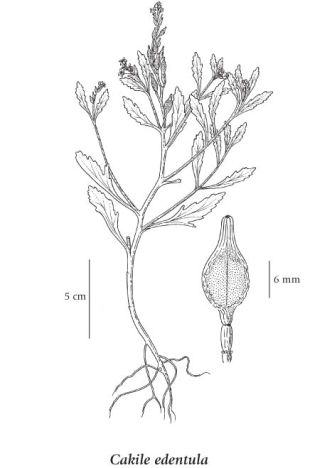American searocket
Brassicaceae (Mustard family)
Introduction to Vascular Plants
Photograph
© Dave Ingram (Photo ID #21253)
SUBTAXA PRESENT IN BC
Species Information
General:
Annual herb from a taproot; stems freely branched, 10-50 cm tall, glabrous, base of lower stems often decumbent.
Leaves:
Basal leaves widely egg- or spoon-shaped, fleshy, deeply toothed to wavy-margined and saw-toothed, with a broad stalk, 2-7 cm long; stem leaves similar.
Flowers:
Inflorescence a raceme, 4-15 cm long; flower stalks 3-7 mm long, stout, ascending; petals white to purplish-tinged, 6-8 mm long; sepals sparsely soft-hairy at tip, early deciduous, 3-4 mm long.
Fruits:
Siliques, 1.5-2.5 cm long, slightly to considerably constricted at the joints, the upper segment triangular to egg-shaped, constricted to somewhat flattened beak, tip acute to notched.
Illustration

If more than one illustration is available for a species (e.g., separate illustrations were provided for two subspecies) then links to the separate images will be provided below. Note that individual subspecies or varietal illustrations are not always available.
Illustration Source: The Illustrated Flora of British Columbia
Ecology
The table below shows the species-specific information calculated from
original data (BEC database) provided by the BC Ministry of Forests and Range.
(Updated August, 2013)
| Site Information |
Value / Class |
||
|
Avg |
Min |
Max |
|
| Elevation
(metres) |
4 | 0 | 15 |
| Slope
Gradient (%) |
1 | 0 | 5 |
|
Aspect (degrees) |
72 | 10 | 135 |
| Soil
Moisture Regime (SMR) [0 - very xeric; 4 - mesic; 8 - hydric] |
1 | 1 | 2 |
| Modal
Nutrient Regime
Class |
A | ||
| #
of field plots species was recorded in: |
10 | ||
| Modal
BEC Zone Class |
CWH | ||
|
All BEC Zones (# of stations/zone) species was recorded in |
CWH(10) | ||
|
Source:
Klinkenberg 2013
|
|||
Habitat and Range
Moist to wet sandy shorelines in the lowland zone; common in coastal BC; N to AK and S to CA, also along the Great Lakes and the Atlantic Coast.Status Information
Taxonomic Keys
1. Silicles slightly to much constricted at the joints, leaves mostly spoon-shaped or egg-shaped, wavy-margined and toothed, sometimes pinnately lobed or nearly entire......................................C. edentula
1. Silicles usually expanded at the joints into projecting wings; at least the lower leaves usually distinctly pinnately cleft..........................C. maritima Source: Illustrated Flora of British Columbia. |